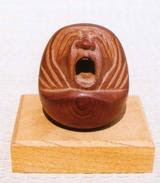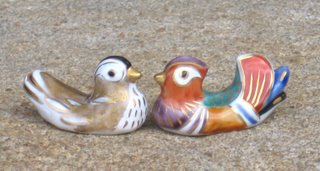:::::::::::::::::::::::::::::::::::::::::::::::::::::::::::::::::::::::::::::::::::::::::::::::::::::
Kimono, Yukata, Nagajuban and more
着物、浴衣、長襦袢 などなど
"Kimono" which is simply the Japanese word for "clothes", has come to mean "traditional Japanese clothing" that evolved during the Heian period (794-1192).
The kimono assumed its present form during the Edo period when it came to be worn as a single layer with the belt tied at the back (until this time it had been tied in the front as is still the custom with yukata and belts on martial arts uniforms).
Also, improved dyeing techniques, such as the "yuzen technique" (a dye-resist dyeing
process), which enabled greater use of colour and made highly decorated multicoloured kimono the norm. Family colours became institutionalized and each daimyo's troops effectively had a uniform, consisting of a kimono, a kamishimo (a sleeveless jacket worn over the kimono), and a hakama (a baggy trouser-skirt). Kimono making had progressed almost to the level of an art form with kimono being handed down like swords as family heirlooms.
- Referecne -
Yamanaka, Norio The Book of Kimono,
Kodansha, 1982

This practical and attractive book makes available for the first time the basic knowledge and vocabulary needed to select and put on a kimono and obi.
Norio Yamanaka was born in Shiga Prefecture in 1928. In 1964 he founded the Sodo Kimono Academy, the first institute of its kind to encourage the wearing of Japan's national dress in everyday life. His philosophy is that wearing the kimono properly depends as much on the person's inner nature as on the garment itself. His movement has spread throughout Japan, and more than five million people have been taught how to wear the kimono by the fifty thousand consultants the academy has graduated.
- Reference -
:::::::::::::::::::::::::::::::::::::::::::::::::::::::::::::::::::::::::::::::::::::::::::::::::::::
quote
The kimono (着物) is a Japanese traditional garment worn by men, women and children. The word "kimono", which literally means a "thing to wear" (ki "wear" and mono "thing"), has come to denote these full-length robes.
Kimono are T-shaped, straight-lined robes worn so that the hem falls to the ankle, with attached collars and long, wide sleeves. Kimono are wrapped around the body, always with the left side over the right (except when dressing the dead for burial.), and secured by a sash called an obi, which is tied at the back. Kimono are generally worn with traditional footwear (especially zōri or geta) and split-toe socks (tabi).
© More in the WIKIPEDIA !
:::::::::::::::::::::::::::::::::::::::::::::::::::::::::::::::::::::::::::::::::::::::::::::::::::::

With more literature about KIMONO
Fashioning Kimono by Reiko Mochinaga Brandon and others.
(Milan: 5 Continents, 2005).
Kimono as Art by Itchiku Kubota.
(London: Thames & Hudson, 2008).
Kimono: Fashioning Culture by Liza Crihfield Dalby.
(New Haven: Yale Univ. Press, 1993).
Kimonos by Sophie Milenovich.
(New York: Abrams, 2007).
Knit Kimono by Vicki Square.
(Loveland, Colo.: Interweave Press, 2007).
When Art Became Fashion by Dale Carolyn Gluckman.
(Calif.: Los Angeles County Museum of Art, 1992).
source : San Francisco Public Library
:::::::::::::::::::::::::::::::::::::::::::::::::::::::::::::::::::::::::::::::::::::::::::::::::::::
Haori Jacket 羽織
A formal kimono can be worn with a haori jacket as well as the hakama.
The haori is held closed with a braided cord tied in a decorative knot. Today this type of outfit is mostly worn for very formal occasions, most commonly by the bridegroom during his wedding ceremony.
source : web.mit.edu/jpnet
During the Edo period, men used a haori with a simple outside material and colorful silk imprints on the inside to show their individualiy.
So we get some nice haori with Daruma san worn inside.
You can well imagine a priest wearing such a haori on a cool autum evening.
.................................................................................

karakoromo, karagoromo 唐衣 Cathay robe
"robe from China"
worn at the Heian Court
針立や肩に槌打つから衣
haritate ya kata ni tsuchi utsu karakoromo
an acupuncurist
pounding into my shoulder;
the cast off robe
Tr. Barnhill
The word haritate here refers to the tools of an acupuncturist.
karakoromo is a pun with a "Chinese robe"唐衣 or a cast-off robe 空衣, meaning a naked body.
Acupuncture and
. Matsuo Basho 松尾芭蕉 - Archives of the WKD .
:::::::::::::::::::::::::::::::::::::::::::::::::::::::::::::::::::::::::::::::::::::::::::::::::::::
My Photoalbum with more Kimono and Material with Daruma
. . . Photo Album . . .
Here are a few more links about my latest aquisitions:
Kimono with great Daruma paintings, start from here to Nr. 19
..www.flickr.com/photos/gabigreve
Haori with small red Daruma inside 羽織にだるま
http://blog.livedoor.jp/gabigreve2000/archives/16927329.html
Ito, Thread with Daruma だるま糸
http://blog.livedoor.jp/gabigreve2000/archives/16925598.html
Kimono white silk 着物
http://blog.livedoor.jp/gabigreve2000/archives/16925966.html
Kimono Gray Shibori Pattern だるま柄、男性物の襦袢
http://blog.livedoor.jp/gabigreve2000/archives/16926331.html
Material Cotton with Daruma Pattern
http://blog.livedoor.jp/gabigreve2000/archives/16928226.html
Nagajuban brown and blue ながじゅばん
See Picture at the top
http://blog.livedoor.jp/gabigreve2000/archives/16933285.html

Edo Shirt for a festival 江戸時代 シャーツ
江戸一 koiguchi shaatsu 鯉口シャツ
http://www.flickr.com/photos/gabigreve2000/641018465/in/set-72157600520911634/
Haori 羽織茶色
http://blog.livedoor.jp/gabigreve2000/archives/20879064.html
Noren, indigoのれん
http://blog.livedoor.jp/gabigreve2000/archives/20878294.html
Furoshiki with Zodiac Animals, tiny Daruma 風呂敷
http://blog.livedoor.jp/gabigreve2000/archives/20876536.html
Yukata with written pattern 浴衣に文字とだるま
http://blog.livedoor.jp/gabigreve2000/archives/20382495.html
Kimono, juban with coins 着物、襦袢と銭の模様
http://blog.livedoor.jp/gabigreve2000/archives/19500490.html
Kimono for a child, Omi Hemp 近江の麻着物、!!!
http://blog.livedoor.jp/gabigreve2000/archives/19502084.html

Silk Thread for Sewing (ito) だるま京美糸
........................................................................................................
Kimono patterns from Yamatoku
A great collection with explanations of Japanese culture.
::::::::::::::::::::::::::::::::::::::::::::::::::::::::::::::::::::::::::::::::::::

Detail

Photos from my friend Ishino.
:::::::::::::::::::::::::::::::::::::::::::::::::::::::::::::::::::::::::::::::::::::::::::::::::::::
sukui ori スクイ織 weaving technique
From Oku Noto Peninsula


Photos from my friend Ishino san.
:::::::::::::::::::::::::::::::::::::::::::::::::::::::::::::::::::::::::::::::::::::::::::::::::::::
quote
Ushikubi-tsumugi 牛首紬 Ushikubi tsumugi Pongee
Ushikubi-tsumugi is a silk fabric made in the Ushikubi area of Shiramine in Hakusan city, Ishikawa prefecture. Ushikubi-tsumugi uses only pure river-bed water from the Tetori River and rare silkworm cocoons called “Tama-Mayu” in its process. The silkworm cocoons are first boiled down, spun by hand, and then elaborately weaved. All aspects of the process are done by hand and the fabric is famous for its strength among other silks.
The origins of Ushikubi-tsumugidate back to the Heian period when the technique was first introduced to the locals by the wife of a Minamoto clan warrior named Oobatake. Oobatake became a fugitive after the Minamoto clan were defeated during Heiji no ran, or the Heiji Rebellion.
Ushikubi-tsumugi was highly regarded for its durability and much sought after during the Edo period. From the middle of the Meiji period to the beginning of the Showa period, silk production steadily increased, however with Japan facing economic depression and eventually war, production soon rapidly declined and the authentic silk industry disappeared all together for a time. After the war, silkworm breeding was resumed and the craft of Ushikubi-tsumugi was successfully revived. Today, Ushikubi-tsumugi is appreciated as one of the highest quality silk fabrics in the world.
source : nippon-kichi.jp

with a little Daruma pattern
. . . CLICK here for Photos !
:::::::::::::::::::::::::::::::::::::::::::::::::::::::::::::::::::::::::::::::::::::::::::::::::::::
.. .. .. .. .. .. .. .. My related articles with more explanations
Winter clothing, fuyumono 冬物 - fuyugi 冬着
. WKD : Warm things in Winter .
including Traditional Japanese Wear
. Tee Shirts ティーシャツ
Nishijin Weaving 西陣織 京都
NOREN Door Curtains のれん 暖簾
Hakama and Haiku trouser-skirt (hakama はかま 袴)
External LINK
Twilight for the Kimono
by Anthony Faiola, Washington Post, December 2006
:::::::::::::::::::::::::::::::::::::::::::::::::::::::::::::::::::::::::::::::::::::::::::::::::::::

visiting the Exhibit of Japanese Art - Nemours, France
a kimono's earth tones
the smell of pine and birch
warmed by the sun
- Shared by Ella Wagemakers -
Joys of Japan, September 2012
Look at more of Ella's photos here :
source : www.facebook.com/media
:::::::::::::::::::::::::::::::::::::::::::::::::::::::::::::::::::::::::::::::::::::::::::::::::::::::::::::::::::::::::::

The Fukiyose pattern depicts the scene of colored leaves or flower petals that are blown together by the autumn wind and fall onto the ground.
Representative motifs of the pattern are maple leaves, chestnuts, pine straws, pine cones, ginkgo and ivy. All these motifs bring us the feeling of autumn.
Fukiyose is very popular particularly outside Japan as the pattern represents the splendor of autumn with a Japanese touch.
. Fukiyose 吹き寄せ .
:::::::::::::::::::::::::::::::::::::::::::::::::::::::::::::::::::::::::::::::::::::::::::::::::::::::::::::::::::::::::::
- - - - - Made of glass!
"Autumn Sunset Kimono" (back & front)
by Markow & Norris (1.52 meters tall x 1.21 meters wide)

- Autumn Sunset is the first in a series of four freestanding life-size kimonos representing the four seasons during different times of day. The kimono features the endless color changes evident in both an autumn changing landscape as well as an ever-changing sunset sky. Autumn Sunset is made of 19 separate pieces of woven glass supported by a metal mannequin. At 125 pounds, Autumn Sunset kimono is the largest woven glass sculpture in the world.
- source : facebook
:::::::::::::::::::::::::::::::::::::::::::::::::::::::::::::::::::::::::::::::::::::::::::::::::::::::::::::::::::::::::::
Kimono and Daruma
BACKUP TEXT only
[ . BACK to WORLDKIGO . TOP . ]
[ . BACK to DARUMA MUSEUM TOP . ]
:::::::::::::::::::::::::::::::::::::::::::::::::::::::::::::::::::::::::::::::::::::::::::::::::::::::::::::::::::::::::::





































